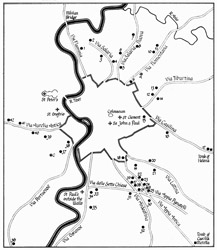
The beginnings of Christian art can be dated to the end of the second century or the early years of the third century A.D. The appearance of a comparatively large body of material from this period is a good testament to the dramatic growth of Christianity in this period. The large number of catacombs ringing Rome as documented by the following map is a good demonstration of this spread of Christianity.
It used to be believed that the catacombs were secretive, but as documented by the map above, they appear along the principal roads leading into Rome. Their appearance outside the walls of Rome follows the Roman custom of not burying the dead within Rome. Christian catacombs were frequently adjacent to non-Christian ones.
The newly won converts to Christianity were products of the classical culture of the Ancient world. Rather than reject their cultural heritage, the new Christians assimilated the classical culture into Christianity. Christian theology, literature, and art of this period bears the unmistakable imprint of this mixing of Christian and classical. For example, the Christian writer Clement of Alexandria, writing at the end of the second and the beginning of the third century, infuses his texts with a strong knowledge of classical literature, mythology, and philosophy. This is well illustrated by an excerpt from a text entitled The Protreptikos. Here we find references to Homer and Plato along side Biblical citations. The image of Christ the Word as the logos and teacher is derived from Greek philosophy.
Christ and the Christian as a philosopher is an important theme in Early Christian art. For example in a catacomb painting Christ as the philosopher is flanked by his disciples much like a representation of Socrates surrounded by his students:
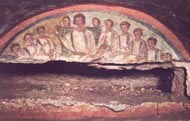
Notice here how Christ is given authority by being represented with the gesture of authority while holding onto a scroll. Even his dress, a toga, is the dress associated with authority. A fourth century painting of St. Paul already has his characteristic pointed beard and dark hair with receding hairline:
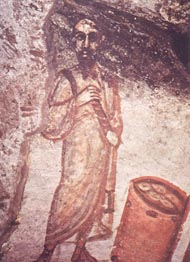
Paul's dress, the scroll in his hands, and the container with more scrolls at his feet, all identify Paul as a philosopher. Compare the painting of St. Paul to a Roman copy of a fourth century BCE portrait of the Greek playwright, Sophocles:
A third century sarcophagus or tomb now in the church of Sta. Maria Antiqua has at its center a representation of a seated man holding a scroll and a standing woman:

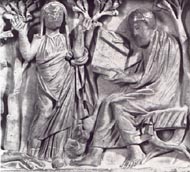
This is clearly based on the Classical formula of the philosopher and his muse. A sixth manuscript made in Constantinople known as the Vienna Dioscorides includes miniatures showing Dioscorides, a first century Greek physician and compiler of this medical encylopedia, accompanied by muses:

While of much later date than the Roman sarcophagus, the Dioscorides manuscript is clearly based on a much earlier prototype. We know that deluxe copies of Classical texts were regularly introduced with author portraits like this.
The formula of the philosopher and his muse appeared on non-Christian sarcophagi as well as illustrated by the following sarcophagus from the early third century:
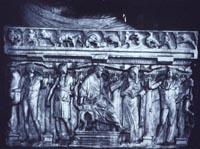
An interesting detail about the Sta Maria Antiqua sarcophagus is the fact that the heads of the man and the woman are unfinished. How would you explain this? What does this say about the status of Christianity at this period and the nature of the art industry in Rome?
The formulas for representing figures in the earliest Christian art were clearly derived from the conventions of Classical art. Compare for example the representation of Jonah sleeping under the gourd to a reclining figure from a mythological sarcophagus:
The gesture of the arm over the head is a formula derived from Greek art for representing sleep. A Hellenistic sleeping Ariadne figure demonstrates the ancestry of this pose:
On the right side of the Santa Maria Antiqua sarcophagus appear two scenes. The first is the theme of the Good Shepherd. While echoing the New Testament parable of the Good Shepherd and the Psalms of David, the motif had clear parallels in Greek and Roman art, going back at least to Archaic Greek art, as exemplified by the so-called Moschophoros, or calf-bearer, from the sixth century B.C.E.
On the far right appears the scene of the Baptism of Christ. A striking contrast between pre-Constantinian and later Christian art is in the selection of subject matter. In the earlier period, we find only very rarely images of the life of Christ. The standard infancy and passion scenes of Christ that we take for granted in Christian art are virtually non-existent in the earliest Christian art. We do find images like Christ performing the miracle of the loaves and fishes or Christ curing the paralytic. The appearance of the Baptism of Christ on the Santa Maria Antiqua sarcophagus might seem to contradict this general rule, but its inclusion is likely a reference to the significance of Baptism as the rite of initiation into the mystery of the faith. The symbolism of the rite like the story of Jonah on the opposite end of the sarcophagus alludes to the theme of death and resurrection.
The typical subject matter in the earliest Christian sculpture and painting are miracle stories like Jonah and the Sea Monster:
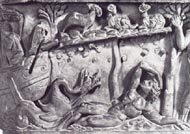
Moses Striking the Rock in the Desert:
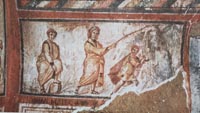
The Three Hebrews in the Fiery Furnace:
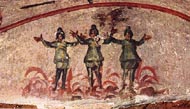
Daniel in the Lions' Den:
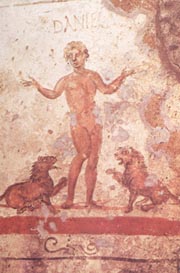
New Testament stories connecting to the life of Christ when they do appear are regularly paired with these Old Testament stories. For example, here a representation of the miracle of Christ curing the paralytic is juxtaposed with another representation of Moses Striking the Rock:

In your journal, consider why there is this major difference in the subject matter of the earliest Christian art from the later tradition. Also consider why these particular subjects are selected. What do they have in common? An important consideration is the status of Christianity during this pre-Constantinian period. Remember that Christianity was one of the large group of religions that were called mystery religions. As implied by the designation, at the core of the religious experience was an essential body of information that was only open to initiates.
In your journal, try to identify the subject matter and meaning of the following sarcophagus from the end of the third century:
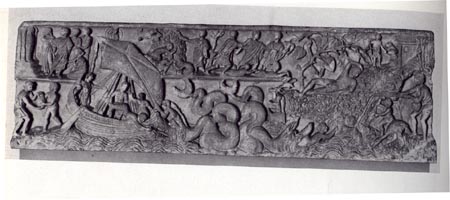
Christ Himself does not appear regularly in this earliest Christian art. He does appear in allegorical guise as we have seen as the Philosopher. One of the most popular guises of Christ in this period was as the Good Shepherd:
Examination of an image like this which comes from the Catacomb of Calixtus again raises the issue of mixing Christian and Classical cultures. The Good Shepherd motif certainly calls to mind the Gospel parables of the lost sheep (Luke 15) and of the shepherd who gives his life for his sheep (John 10). Also the shepherd plays an important role in the Old Testament book of Psalms. But the shepherd was also popular as an allegorical figure in classical art and culture. It is significant to note that the style of this painting with its loose impressionistic style and suggestion of landscape space echoes a category of ancient painting called sacral-idyllic landscapes:
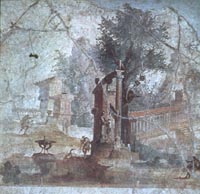
There is nothing distinctively Christian about the layout of the vault of the catacomb by dividing it up into geometric shapes:
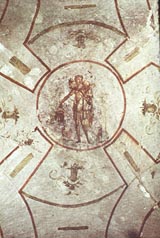
A major topic of consideration in this course will be the development of Christian church architecture. It is important to understand that there was a profound change in conception of the Christian church after Constantine's patronage of Christianity. Christian buildings before Constantine were based on typical Roman domestic architecture. This is best exemplified by a drawing of the remains of a Christian meeting house in Dura Europos:
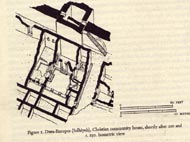
Archaeologists have shown that this traditional Roman house centered around an open court or atrium was built around the year 200 A.D. Around 230 the building was modified to meet the needs of the local Christian community. These changes included the elimination of a wall to form a larger oblong space to accomodate the liturgical celebrations of the community. The most significant change was the modification of a room to become a room to celebrate the sacrament of Baptism. Changes included the addition of a tub along one wall and the decoration of the walls with murals echoing the symbolism of Baptism:
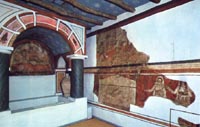
On the long wall appears the story of the Holy Women as the Tomb of Christ while above appears parts of the story of Jonah and the Sea Monster. Both of these stories are important typological representations associated with Baptism. Why would there have been so much attention directed to a special room for Baptisms?